Key takeaways:
- The immune system comprises innate and adaptive responses, with innate immunity acting as a rapid first line of defense against pathogens.
- Factors like age, nutrition, and stress significantly influence immune responses, highlighting the need for tailored health approaches.
- Immune profiling techniques, such as mass cytometry and single-cell RNA sequencing, enhance disease management by personalizing treatment and improving vaccination strategies.
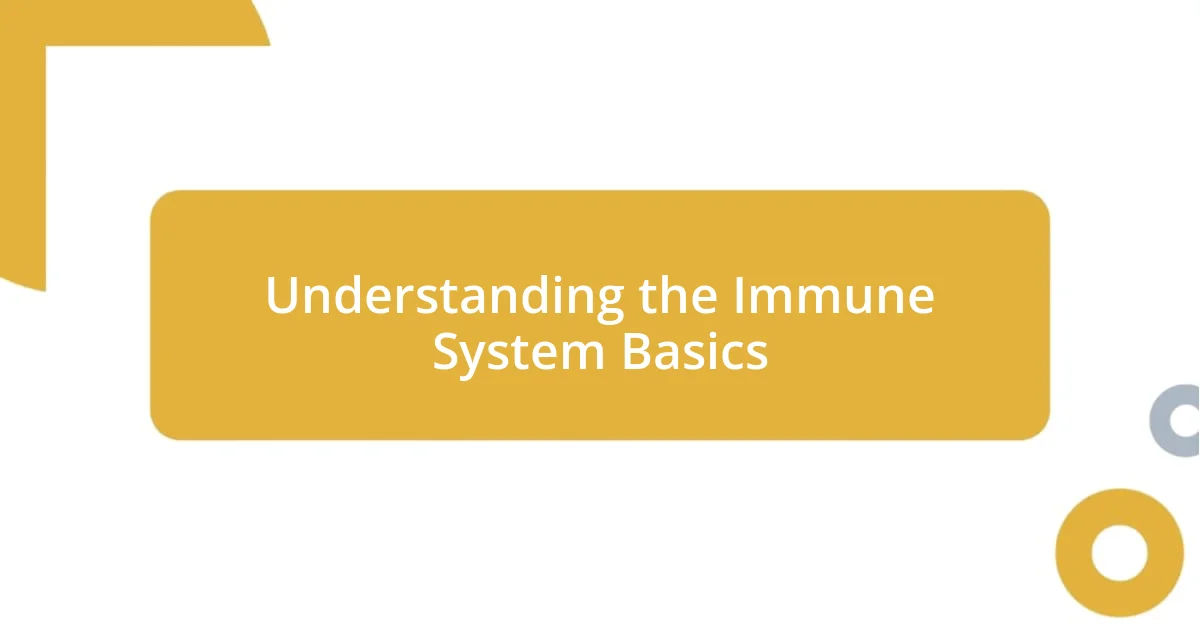
Understanding the Immune System Basics
To grasp the basics of the immune system, it’s essential to recognize that it operates as a finely tuned orchestra. Each component, from white blood cells to antibodies, plays a unique role in defending the body against pathogens. Isn’t it fascinating how this complex system can identify and remember countless invaders?
In my experience, understanding how the immune system distinguishes between friend and foe can be truly eye-opening. For instance, when I learned about T-cells—those vigilant soldiers that hunt down infected cells—I couldn’t help but appreciate how they can remember past enemies like a seasoned detective. It raises the question: how does our body keep such precise records of past infections?
The interplay between innate and adaptive immunity adds another layer of complexity. It’s like having a first line of defense ready at all times while also having a specialized team that can adapt and learn over time. Reflecting on this balance reminds me of the resilience I’ve seen in people who recover from illness—it’s a powerful testament to the body’s capacity for healing and adaptation.
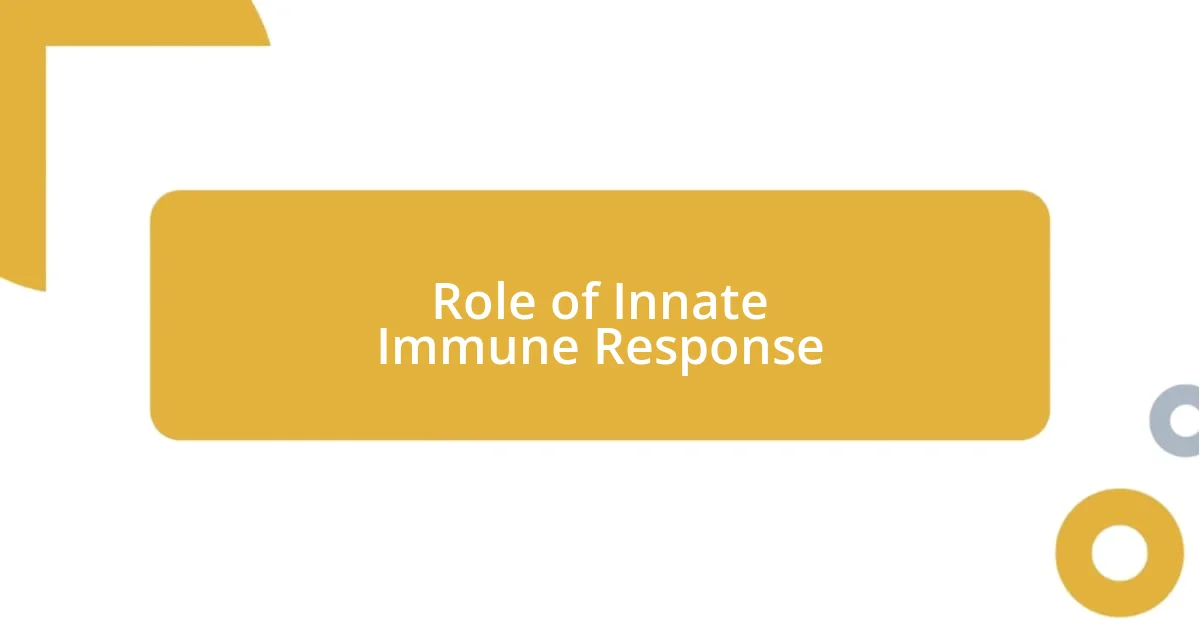
Role of Innate Immune Response
The innate immune response serves as our body’s first line of defense, acting swiftly to combat intruders. I often think of it as a rapid response team that doesn’t wait for orders; it acts as soon as a threat is detected. When I was studying immunology, I was amazed to learn how quickly innate immune cells, like macrophages and neutrophils, can spring into action, essentially serving as the body’s first responders.
- It recognizes pathogens through pattern recognition receptors (PRRs).
- Cells like macrophages engulf and digest harmful invaders.
- Inflammatory signals are released to rally additional immune cells.
- Natural killer (NK) cells identify and destroy compromised host cells.
- This response operates without prior exposure to the pathogen, ensuring immediate protection.
Reflecting on this amazing system reminds me of the urgency and commitment in a crisis; those moments when quick thinking and decisive action can save lives. The innate response is not just mechanical; it carries a non-specific, yet focused, passion for safeguarding our health. It’s a beautiful example of how our body employs instinctual reactions, where every second counts.
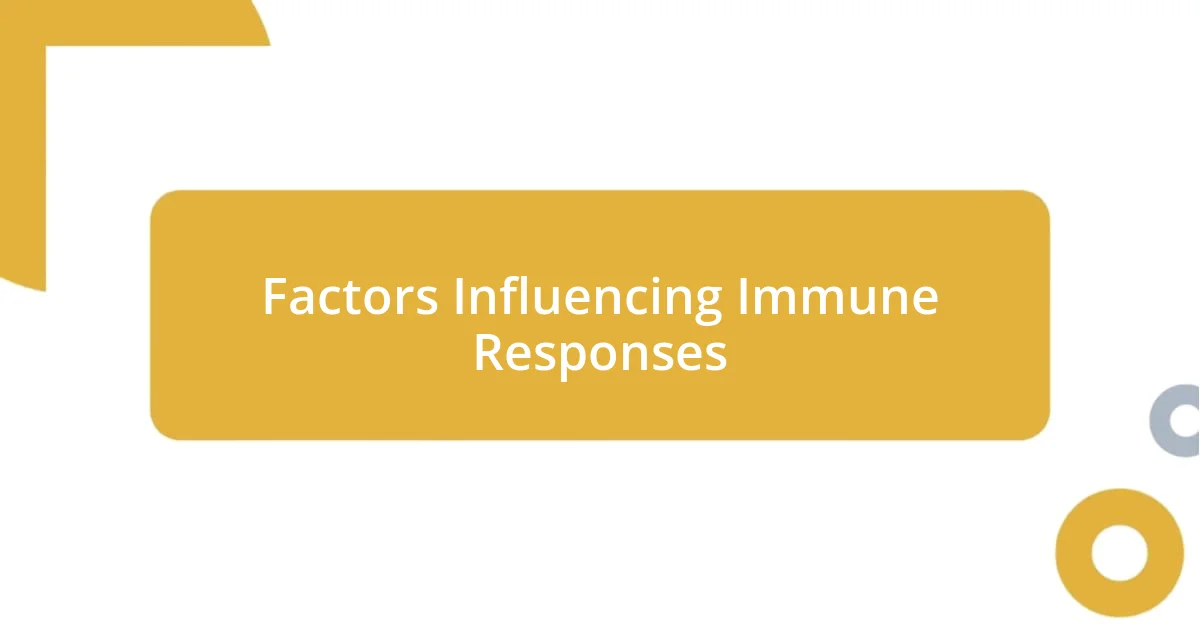
Factors Influencing Immune Responses
Often, the internal and external environment can significantly alter how our immune system responds. Factors such as age, genetics, and overall health play pivotal roles. I remember a time when a close friend, who was in their 60s, faced a recurring infection; it became apparent how age can affect immune efficiency. With older individuals, the immune system may not respond as robustly, highlighting the need for tailored health approaches.
Nutrition is another critical factor influencing immune responses. I’ve personally seen the difference that a balanced diet can make; during a particularly stressful period in my life when I neglected my nutrition, I noticed I fell ill more often. Our body requires essential vitamins and minerals to maintain optimal immune functionality, and my experience taught me that nourishing our bodies with the right foods can bolster our defenses.
Stress serves as a double-edged sword, weighing heavily on immune response. I recall when I was juggling a demanding job; stress seemed to amplify my allergy symptoms, and I realized how deeply connected our emotional well-being is to our physical health. The body responds to stress by releasing hormones, like cortisol, which can suppress immune function over time. Recognizing this interplay has motivated me to adopt stress management practices that prioritize both mental and physical health.
| Factor | Influence on Immune Response |
|---|---|
| Age | Older individuals often experience a decline in immune efficiency. |
| Nutrition | A balanced diet supports immune system functionalities. |
| Stress | Chronic stress can suppress immune function, leading to increased vulnerability. |
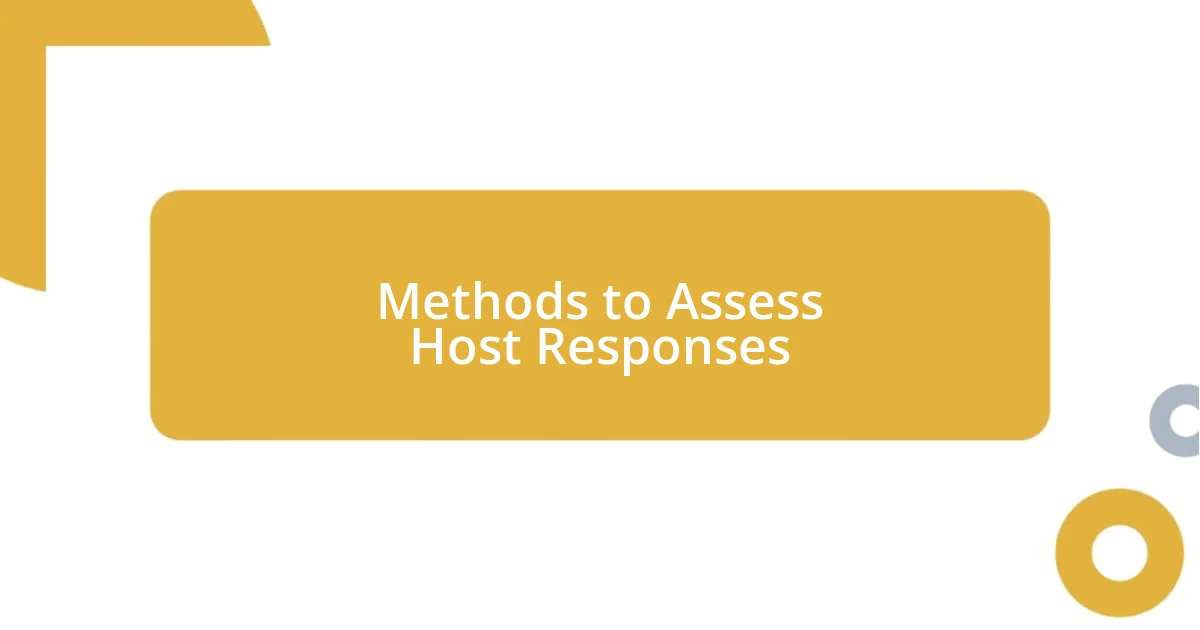
Methods to Assess Host Responses
Assessing host immune responses is crucial for understanding how our bodies react to infections or diseases. One method that stands out to me is flow cytometry, which allows researchers to analyze the characteristics of immune cells. I recall the first time I saw this technique used; it was like watching a high-tech movie scene where individual cells were being classified and sorted, revealing their responses to pathogens. Isn’t it fascinating to think that we can literally visualize how our immune system mobilizes?
Another method that’s really piqued my interest is the use of cytokine profiling. This can tell us which signaling molecules are released during an immune response. I remember a laboratory experiment where we measured cytokine levels in response to a vaccine. The excitement in the room was palpable as results began to pour in. The variation in cytokine expression really highlighted how personalized our immune responses can be. It’s a perfect reminder that, like our experiences, no two immune responses are exactly the same.
So, how can we measure these immune responses reliably? One commonly employed approach is serological assays, which evaluate the presence of antibodies in the blood. I can’t help but think back to when I volunteered at a health clinic. We used serological tests to monitor patients’ responses to treatment. The relief and hope we saw on their faces when learning their antibody levels had increased was incredibly rewarding. It drove home the point that these assessments are more than figures; they represent people’s health journeys.
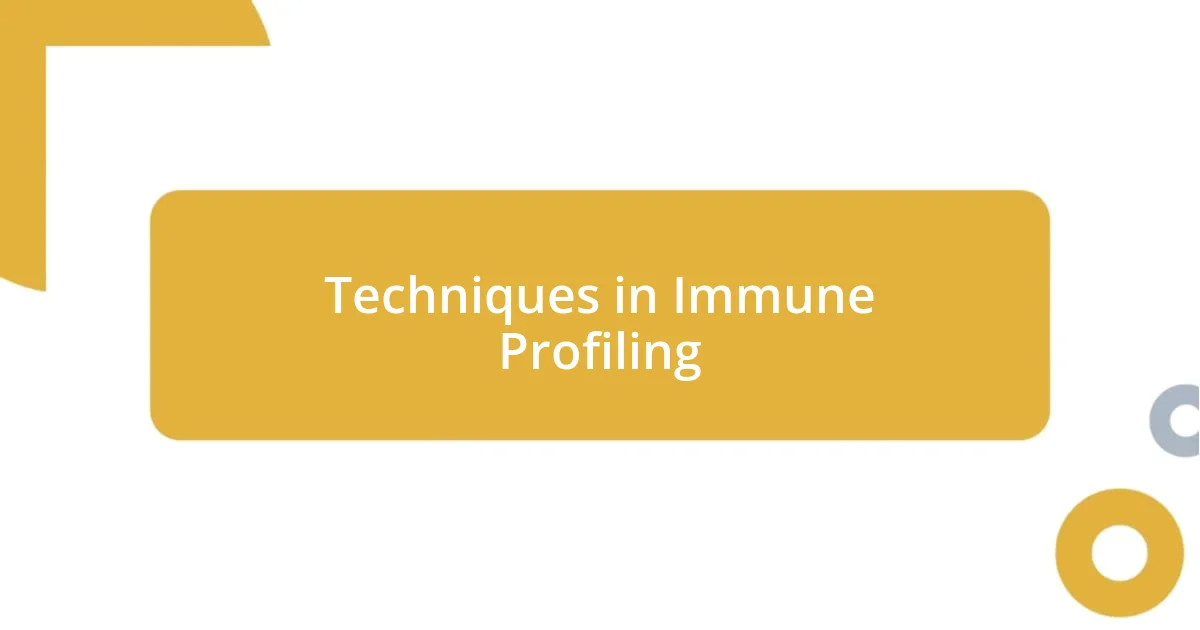
Techniques in Immune Profiling
One prominent technique in immune profiling is mass cytometry, which has transformed how we analyze immune cell populations. The first time I encountered this technique, I was struck by its ability to measure dozens of parameters simultaneously, painting a comprehensive picture of the immune landscape. It’s like an orchestra playing in harmony, where each immune cell’s role and function is highlighted in relation to others. Have you ever wondered how intricate our immune responses truly are? This technique showcases complexity in a way that feels almost poetic.
Another vital approach is single-cell RNA sequencing (scRNA-seq), which allows researchers to examine the gene expression of individual cells. I remember attending a talk where a researcher shared their findings on how scRNA-seq revealed unexpected immune responses in a mouse study. It was thrilling to see how this technology could uncover such nuanced details about cellular behavior. Isn’t it amazing to think that within each cell lies a story waiting to be told?
Lastly, the use of bioinformatics tools for analyzing immune profiles cannot be overlooked. These tools help make sense of vast amounts of data generated from techniques like flow cytometry and scRNA-seq. Reflecting on my experience with data analysis, I found it both challenging and rewarding. It’s similar to piecing together a puzzle; each piece, representing a unique immune response, contributes to a larger understanding of health. This intersection of technology and biology fascinates me. It pushes us closer to truly personalized medicine, where treatment can be tailored based on our unique immune signatures.
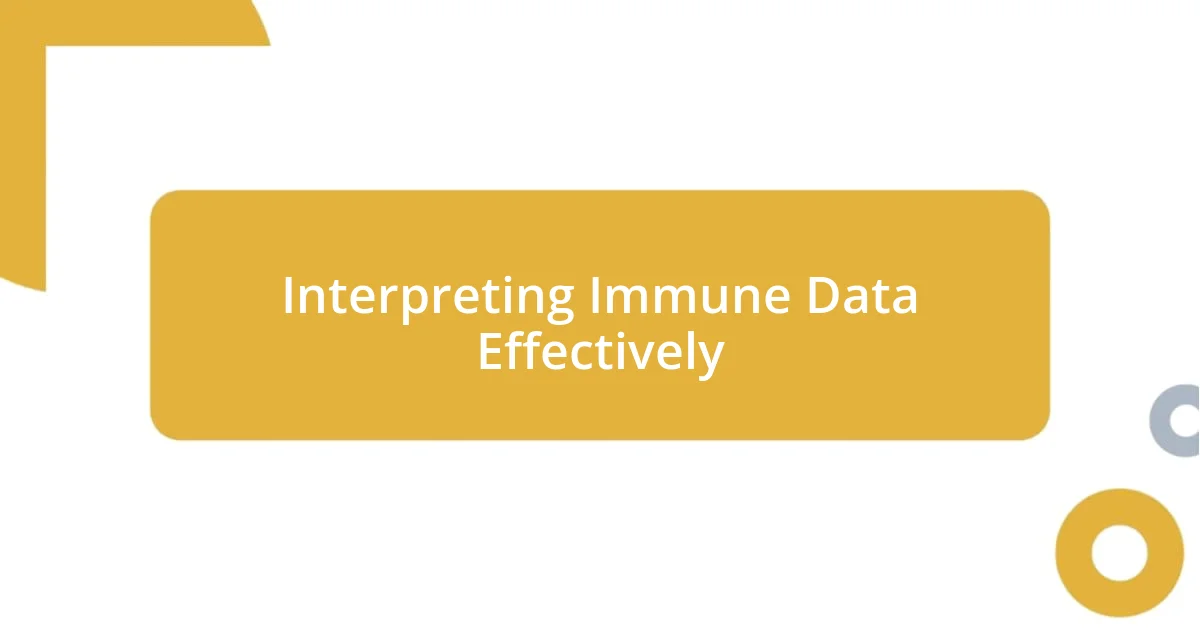
Interpreting Immune Data Effectively
Interpreting immune data effectively boils down to understanding the nuances of what those numbers and graphs really mean. I remember sitting at my desk, squinting at a complex series of figures from an immune study, and feeling overwhelmed. But rather than letting that confusion win, I started breaking down the results piece by piece, questioning each aspect. For example, how does the variation in T cell counts correlate with patient outcomes? This approach transformed my understanding from mere data reading to a deeper analysis of implications.
One thing that often gets overlooked is the context in which the data was collected. I vividly recall a seminar where a leading researcher emphasized the importance of the conditions under which immune responses are measured. It struck me how factors like age, sex, and even environmental exposures play a critical role. Have you ever thought about how your own lifestyle might influence your immune profile? This reflection reminded me that interpreting immune data isn’t just about knowing the numbers; it’s about appreciating their story within the broader canvas of health.
Lastly, collaboration becomes incredibly vital when analyzing immune data. I’ll never forget my first experience working on a team analyzing immune markers from a clinical trial. Sharing insights with colleagues from different backgrounds illuminated aspects I might have missed on my own. It’s like assembling a mosaic—each person adds unique tiles that, together, create a vibrant image of understanding. So, how can we leverage these collaborative efforts? I believe that fostering open discussions around the data can lead to richer, more comprehensive insights that ultimately enhance our understanding of immune responses.

Applications in Disease Management
In my experience, leveraging immune profiling offers exciting potential for managing chronic diseases like autoimmune disorders. When a friend was diagnosed with rheumatoid arthritis, the doctor utilized specific immune markers to tailor her treatment plan. It was fascinating to see how the physician could adjust medications based on her individual immune response, leading to much better outcomes. Have you ever considered how personalizing treatment could change lives?
I’m also particularly intrigued by how immune responses can guide vaccination strategies. While volunteering at a local clinic, I witnessed firsthand the importance of understanding different immune profiles within the community. Patients were much more receptive to getting vaccinated when they understood how their unique immune responses could impact their health. Isn’t it remarkable to think that education about our immune systems can empower individuals to take charge of their health decisions?
Moreover, in oncology, monitoring immune responses has become crucial for predicting treatment efficacy. While attending a recent conference, I learned how researchers track changes in tumor-infiltrating lymphocytes to determine the success of immunotherapies. It was a lightbulb moment for me—understanding that the relationship between the immune system and cancer treatment can directly influence recovery. Isn’t it inspiring to think we’re on the cusp of breakthroughs that could reshape cancer care through a deeper understanding of immunology?














